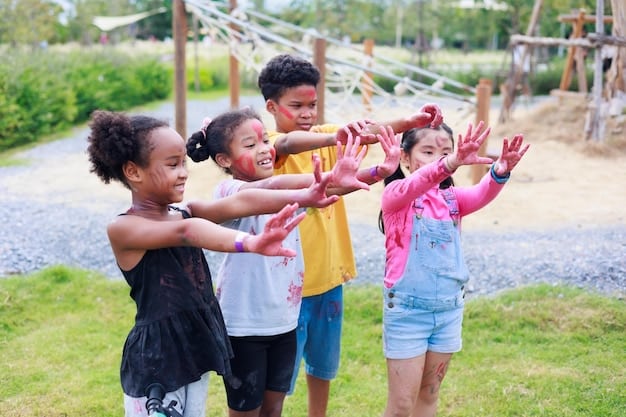Foster Emotional Intelligence in Children: 7 Techniques

Teaching children emotional intelligence involves equipping them with the vital skills needed to understand, express, and manage their own emotions effectively, as well as empathize with others, fostering resilience and stronger social connections.
Raising emotionally intelligent children is an aspiration for many parents and caregivers, recognizing that mastery over emotions is as crucial as academic achievement. In a world that often prioritizes cognitive skills, the capacity to understand and manage one’s feelings, and to effectively navigate social complexities, can profoundly impact a child’s well-being and future success. This guide explores How to Foster Emotional Intelligence in Children: 7 Proven Techniques for a Happier Child, offering actionable strategies to cultivate these essential life skills from an early age, building a foundation for resilience, empathy, and meaningful relationships.
Understanding Emotional Intelligence in Childhood
Emotional intelligence, often abbreviated as EQ, refers to an individual’s ability to identify, understand, manage, and express their own emotions, as well as to perceive, interpret, and respond to the emotions of others. For children, developing these skills is fundamental for healthy development, impacting everything from classroom performance and friendships to mental health later in life. It’s not about suppressing feelings, but rather about learning to process them constructively.
Children naturally experience a wide range of emotions, from joy and excitement to frustration and sadness. Without proper guidance, these feelings can feel overwhelming and lead to outbursts or withdrawal. By helping them develop emotional intelligence, we provide them with the tools to navigate these internal experiences and external interactions more effectively. This critical skill set helps children cultivate resilience, adapt to challenges, and build strong, healthy relationships.
The Pillars of Emotional Intelligence for Kids
Emotional intelligence in children is built upon several interconnected pillars, each contributing to a child’s overall emotional well-being and social competence. Understanding these components can help parents and educators focus their efforts more effectively when teaching these skills. These pillars encompass both internal awareness and external social interaction, forming a holistic approach to emotional growth.
- Self-Awareness: The ability to recognize and understand one’s own emotions. This includes identifying feelings as they happen and understanding the link between emotions, thoughts, and actions.
- Self-Regulation: Managing one’s emotions and impulses. This means being able to soothe oneself when upset, adapt to change, and handle difficult emotions without spiraling into negative behavior.
- Motivation: Using emotions to drive oneself towards goals. Emotionally intelligent children can channel their enthusiasm for learning or their determination to overcome obstacles.
- Empathy: Understanding and sharing the feelings of others. This involves being able to “read” social cues and respond compassionately to the emotional experiences of peers and family members.
- Social Skills: The capacity to interact effectively with others. This includes communication, collaboration, conflict resolution, and building strong, positive relationships.
Nourishing these pillars requires consistent effort and a supportive environment where children feel safe to explore their feelings. It’s a continuous process of learning and adapting, with parents and educators serving as crucial guides.
Technique 1: Be an Emotion Coach
One of the most powerful ways to foster emotional intelligence in children is for parents and caregivers to act as “emotion coaches.” This technique involves actively helping children understand and manage their feelings rather than dismissing or suppressing them. It’s about validating their emotional experiences while gently guiding them toward constructive responses.
Emotion coaching isn’t just about comforting a child; it’s about teaching them valuable lifelong skills for emotional literacy. When children understand that their feelings are normal and acceptable, they are more likely to seek help and develop healthy coping mechanisms. This approach builds trust and strengthens the parent-child bond, creating a safe space for emotional expression.
Steps for Effective Emotion Coaching
Becoming an effective emotion coach involves a conscious effort to engage with a child’s emotional world. It requires patience, empathy, and a willingness to step into their perspective. By following certain steps, parents can create a nurturing environment where emotional intelligence can flourish.
- Notice and Label Emotions: Pay close attention to your child’s emotional cues, both verbal and non-verbal. Help them put words to their feelings by saying, “It looks like you’re feeling frustrated right now,” or “Are you feeling sad about that?”
- Validate Feelings: Let your child know that their emotions are valid and understandable. Phrases like, “It makes sense that you’d feel angry when your toy broke,” or “I understand why you’re feeling scared,” can be incredibly reassuring.
- Set Limits on Behavior: While all feelings are acceptable, not all behaviors are. Clearly communicate boundaries. “It’s okay to be angry, but it’s not okay to hit your sister.” This teaches self-control without shaming the emotion itself.
- Problem-Solve: Once the emotion is acknowledged and calmed, help your child brainstorm solutions or coping strategies. “What could we do next time you feel this way?” or “How can we make this situation better?”
This systematic approach provides children with a framework for understanding their internal states, allowing them to gain control over their reactions and develop resilience. It transforms difficult moments into teachable ones, paving the way for emotional growth.
Technique 2: Model Emotional Self-Regulation
Children learn best by observing the adults around them. Therefore, one of the most impactful techniques for fostering emotional intelligence is to actively model emotional self-regulation. This means demonstrating how you identify, process, and manage your own emotions in healthy ways. When parents and caregivers show emotional maturity, children naturally pick up on these behaviors, internalizing them as their own coping strategies.
Modeling isn’t about being perfect; it’s about being authentic and demonstrating conscious effort. When you openly acknowledge your own feelings, explain how you’re dealing with them, and even show vulnerability, you provide a powerful example for your child. They learn that everyone experiences difficult emotions and that there are constructive ways to handle them.
Showing Your Child How You Cope
Practical demonstrations of emotional management can be incredibly effective. Children need to see these moments unfold in real-time to understand the process. It’s not enough to simply tell them what to do; they need to witness it and understand the “why” behind your actions.
- Verbalize Your Emotions: When you’re feeling stressed, say, “I’m feeling a bit overwhelmed right now, so I’m going to take a deep breath.”
- Explain Your Coping Mechanisms: If you’re upset, you might say, “I’m feeling frustrated, so I’m going to take a short walk to clear my head.” This shows them concrete strategies.
- Apologize When Necessary: If you lose your temper, apologize genuinely and explain what you could have done differently. “I’m sorry I raised my voice; I was feeling impatient. Next time, I’ll try to count to ten.”
Such transparency helps children understand that emotions are a normal part of life and that coping skills are essential tools for navigating them. It normalizes emotional challenges and encourages them to adopt similar strategies.

Technique 3: Teach Empathy Through Storytelling and Role-Playing
Empathy, the ability to understand and share the feelings of another, is a cornerstone of emotional intelligence. It allows children to connect deeply with others, fostering kindness, compassion, and stronger social bonds. While some children may naturally exhibit more empathy than others, it is a skill that can be developed and strengthened through intentional practice and guidance. Storytelling and role-playing offer excellent avenues for cultivating this crucial ability.
When children engage with narratives—whether through books, movies, or imaginary play—they step into the shoes of different characters and experience situations from varied perspectives. This imaginative exercise helps them process complex social dynamics and understand emotional responses they might not encounter directly in their daily lives. Role-playing takes this a step further, allowing them to embody these perspectives actively.
Practical Approaches to Nurture Empathy
Integrating empathy-building activities into your child’s routine can be both fun and highly effective. These activities provide a safe and engaging environment for children to explore emotions beyond their own, fostering a deeper understanding of human connections.
- Discuss Characters’ Feelings: While reading a book or watching a show, pause and ask, “How do you think that character is feeling right now? Why?” Encourage them to consider the character’s facial expressions, body language, and the situation.
- Create Imaginary Scenarios: Engage in role-playing games where children pretend to be someone else. “What would it feel like if you were the new kid in school?” or “How would the puppy feel if you accidentally stepped on its tail?”
- Highlight Real-Life Empathy: Point out acts of kindness and empathy you witness in daily life or in your own family. “Look how your brother helped his friend when they fell. That was very kind of him.”
Through these guided discussions and playful explorations, children begin to recognize the emotional states of others and develop a greater capacity for compassion. This foundational understanding is vital for navigating friendships and social interactions with sensitivity and care.
Technique 4: Create a Safe Space for All Emotions
One of the most critical elements in fostering emotional intelligence is establishing an environment where children feel secure enough to express all their emotions, not just the “good” ones. A safe space means that feelings like anger, sadness, fear, and frustration are acknowledged as normal human experiences, rather than being shamed, dismissed, or punished. When children learn that their feelings are acceptable, they are more likely to communicate openly and develop healthy coping mechanisms.
This approach stands in contrast to the common societal tendency to inadvertently suppress certain emotions, often telling children to “stop crying” or “don’t be angry.” While the intent might be to comfort or control behavior, it can inadvertently teach children that some feelings are bad and should be hidden. Allowing for full emotional expression, within appropriate behavioral limits, is key to emotional development.
Building an Emotionally Safe Environment
Creating such a space requires conscious effort and consistent messaging from parents and caregivers. It involves not only what you say, but also how you react and what non-verbal signals you send when your child expresses difficult emotions.
- Avoid Judgment: When a child expresses a messy or intense emotion, avoid critical responses like, “Don’t be silly,” or “You’re overreacting.” Instead, validate their experience.
- Listen Actively: Give your child your full attention when they are trying to communicate their feelings. Let them articulate what they are experiencing without interruption, even if it’s difficult for you to hear.
- Use Emotion Language: Regularly use a rich vocabulary for emotions. Instead of just “happy” or “sad,” introduce words like “frustrated,” “disappointed,” “excited,” “anxious,” or “proud.”
- Reassure and Support: Let your child know that you are there for them, regardless of the emotion they are feeling. “I’m here for you,” or “It’s okay to feel that way, and we’ll figure it out together.”
By consciously building this safe emotional haven, children learn to trust their internal experiences and develop the confidence to navigate their feelings constructively. This trust is invaluable for their long-term emotional health and their ability to form secure attachments.
Technique 5: Encourage Problem-Solving and Decision-Making
Once a child can identify and express their emotions, the next crucial step in developing emotional intelligence is empowering them with problem-solving and decision-making skills. Life is full of challenges, and children who learn how to approach problems thoughtfully, consider alternatives, and make informed choices are better equipped to manage their emotional responses to obstacles. This not only builds resilience but also fosters a sense of competence and independence.
Rather than jumping in to fix every problem for your child, creating opportunities for them to struggle—and then succeed—in finding solutions is incredibly beneficial. This doesn’t mean leaving them to flounder, but rather providing a framework within which they can explore solutions with your guidance. This approach shifts the focus from avoiding negative emotions to actively working through situations that cause them.
Guiding Children to Find Solutions
Encouraging problem-solving isn’t about giving children the answers, but about teaching them a process to arrive at their own solutions. This process strengthens their critical thinking, confidence, and ability to manage frustration when things don’t go as planned.
- Ask Open-Ended Questions: Instead of offering a solution, ask, “What do you think we could do about this?” or “What are some different ways we could try to solve this problem?”
- Brainstorm Together: Help them generate multiple ideas, no matter how outlandish they might seem initially. Emphasize that all ideas are welcome in the brainstorming phase.
- Evaluate Consequences: Once ideas are on the table, discuss the potential outcomes of each. “If you do A, what might happen? If you do B, what might happen instead?”
- Support Their Choice: Once they’ve chosen a solution, support their decision, even if it’s not the one you would have made. Allow them to experience the natural consequences (within safe limits) and learn from the outcome.
By empowering children to actively participate in resolving their own challenges, we equip them with invaluable skills that extend far beyond the immediate situation. They learn that they possess the agency to positively influence their circumstances, fostering a crucial sense of self-efficacy.
Technique 6: Promote Social Skills and Positive Relationships
Social skills are a vital component of emotional intelligence, enabling children to interact effectively with others, build meaningful friendships, and navigate group dynamics. These skills encompass communication, cooperation, conflict resolution, and the ability to understand social cues. Strong social bonds not only contribute to a child’s happiness and sense of belonging but also provide critical emotional support, reinforcing emotional regulation and overall well-being.
In today’s interconnected world, where digital interactions sometimes overshadow face-to-face engagements, actively fostering strong social skills is more important than ever. Children need explicit guidance in areas such as sharing, taking turns, listening, and resolving disagreements constructively. These are not innate abilities for all children; many require direct teaching and ample opportunities for practice.
Building Blocks for Positive Social Interactions
Parents and caregivers play a pivotal role in creating environments that encourage positive social development. By providing structure, guidance, and opportunities for social engagement, we can help children build a robust foundation for healthy relationships.
- Facilitate Play Opportunities: Arrange playdates and group activities where children can practice interacting with peers. Supervise these interactions to offer gentle guidance when conflicts arise.
- Teach Specific Skills: Explicitly teach concepts like sharing, taking turns, saying “please” and “thank you,” listening when others speak, and how to apologize genuinely. Role-play these scenarios to make them concrete.
- Encourage Cooperation: Involve children in collaborative tasks, whether through family chores, board games, or group projects. Emphasize the value of working together towards a common goal.
- Discuss Conflict Resolution: When disagreements happen, guide children in discussing their feelings, listening to the other person’s perspective, and finding mutually agreeable solutions. Avoid taking sides or simply imposing a solution.
By prioritizing the development of robust social skills, we empower children to thrive in diverse social settings, fostering a sense of belonging and equipping them with the tools they need to build lasting positive relationships throughout their lives.

Technique 7: Practice Mindfulness and Emotional Awareness
In an increasingly fast-paced and stimulating world, teaching children mindfulness and emotional awareness provides them with crucial tools for navigating their internal landscape. Mindfulness is the practice of being present and fully aware of the current moment, including one’s thoughts, feelings, and bodily sensations, without judgment. For children, this translates into a heightened ability to recognize their emotions as they arise, pause before reacting, and choose how to respond rather than simply reacting impulsively.
Integrating mindfulness into a child’s routine can significantly enhance their emotional intelligence by cultivating self-awareness and self-regulation. It helps them to understand that thoughts and feelings are often fleeting and that they have control over how they engage with these internal experiences. This is a skill that offers lifelong benefits, aiding in stress reduction, improved focus, and a greater sense of calm and well-being.
Simple Ways to Introduce Mindfulness to Children
Mindfulness doesn’t have to be complicated or intimidating. There are many fun and accessible ways to introduce these concepts to children, making them an integral part of their daily lives. The key is to make it playful and relevant to their experiences, rather than feeling like another chore.
- “Belly Breathing”: Teach children to place a hand on their belly and notice it rise and fall with each breath. Explain that this can help them calm down when they feel big emotions. “Breathe in peace, breathe out worry.”
- “Emotion Check-In”: Regularly ask, “How are you feeling right now? Where do you feel that in your body?” Encourage them to notice physical sensations associated with emotions, like a tight stomach with anxiety or a fluttery heart with excitement.
- Mindful Sensory Activities: Engage their senses by encouraging them to truly focus on one thing. “What do you hear right now? What does this food taste like?” This helps them pay attention to the present moment.
- Gratitude Practice: At bedtime or dinner, ask everyone to share one thing they are grateful for. This shifts focus to positive emotions and appreciation.
By regularly practicing mindfulness, children develop a greater capacity for self-observation, allowing them to gain control over their emotional responses and fostering a deeper connection with their inner world. This practice provides a solid foundation for lifelong emotional well-being and resilience.
| Key Practice | Brief Description |
|---|---|
| 🗣️ Emotion Coach | Validate feelings, label emotions, and guide children to constructive coping. |
| 🧘 Model Regulation | Show children how you handle your own emotions in a healthy way. |
| 📖 Teach Empathy | Use stories and role-playing to help children understand others’ perspectives. |
| ️️️☮️ Safe Emotional Space | Allow children to express all emotions without judgment, fostering open communication. |
Frequently Asked Questions About Fostering Emotional Intelligence
Emotional intelligence (EQ) is the ability to understand, manage, and express one’s own emotions, and to perceive and respond to the emotions of others. For children, it’s crucial because it fosters resilience, better social skills, academic success, and overall mental well-being, helping them navigate life’s challenges more effectively and build stronger relationships.
Emotional intelligence can and should be nurtured from a very early age. Even toddlers can begin to learn basic emotional vocabulary and self-regulation through consistent guidance and modeling from parents. It’s a continuous developmental process that evolves as children grow, so starting early provides a strong foundation.
To teach children to manage big emotions, start by validating their feelings and then guide them to healthy coping mechanisms. This can include deep breathing exercises, taking a “calm down” break, using verbal expressions instead of physical ones, or finding constructive ways to release energy, like drawing or physical activity.
No, a child cannot be “too” emotionally intelligent. More accurately, they might be highly sensitive or empathetic. However, high emotional intelligence provides robust tools for managing complex feelings and social situations. The goal is balance: understanding emotions without being overwhelmed by them, and using them to navigate life more effectively.
Schools play a significant role through social-emotional learning (SEL) programs that teach skills like self-awareness, self-management, social awareness, relationship skills, and responsible decision-making. These programs complement home-based learning, offering a structured environment for children to practice and apply emotional intelligence skills with peers and educators.
Conclusion
Fostering emotional intelligence in children is not merely about teaching them how to behave, but empowering them with a profound understanding of their inner world and the social dynamics that shape their lives. The seven techniques discussed—being an emotion coach, modeling self-regulation, teaching empathy, creating emotional safe spaces, encouraging problem-solving, promoting social skills, and practicing mindfulness—each contribute significantly to building a foundation of emotional resilience and competence. By consistently applying these strategies, parents and caregivers do more than just raise happier children; they equip them with indispensable life skills that will guide them toward becoming compassionate, well-adjusted, and successful adults capable of navigating an ever-changing world with grace and integrity. The investment in their emotional development today will yield dividends throughout their lives.





